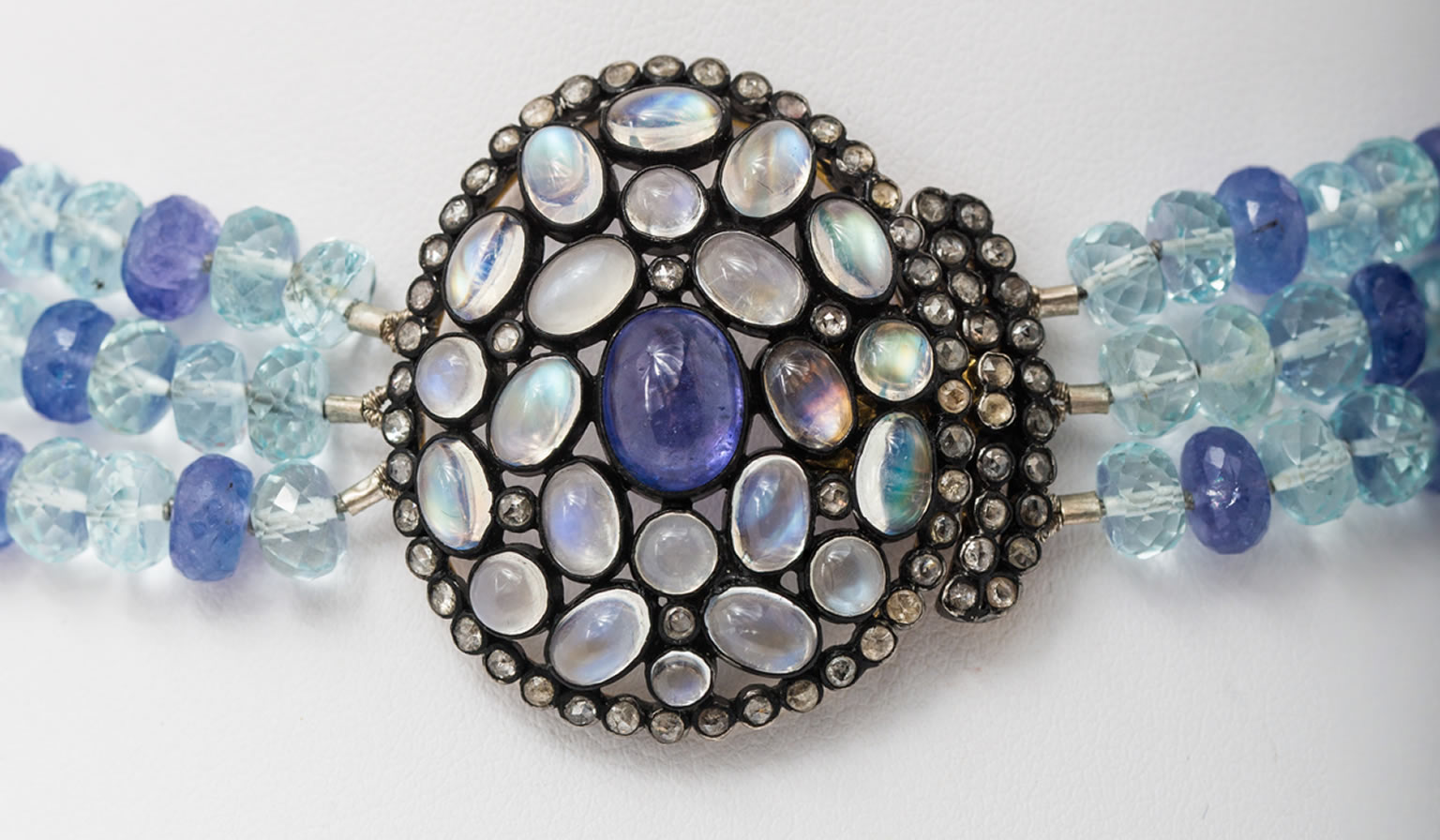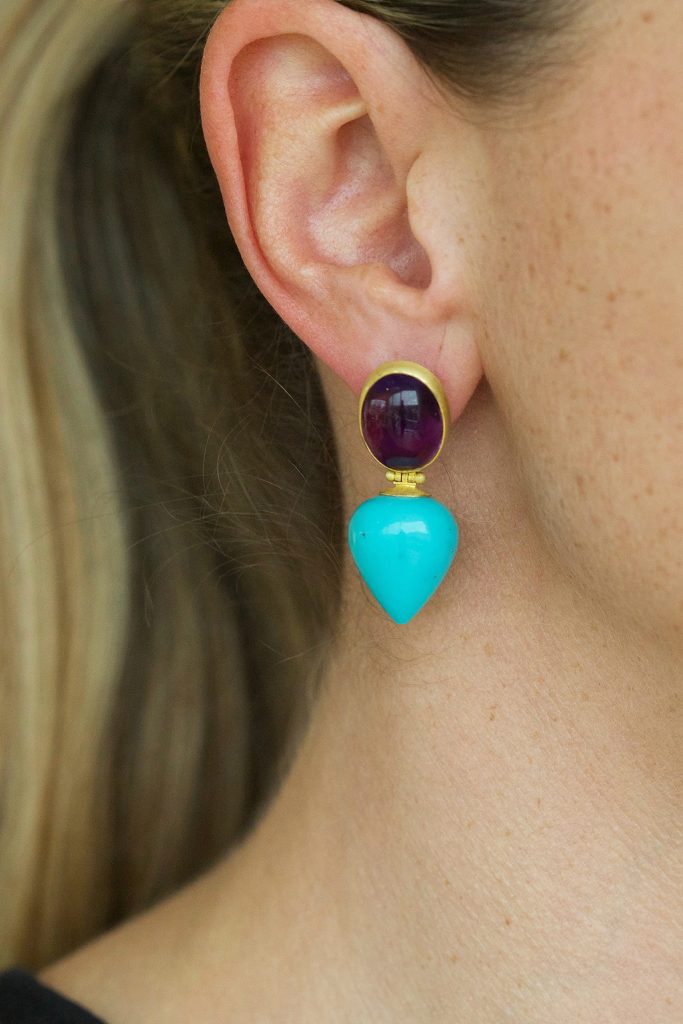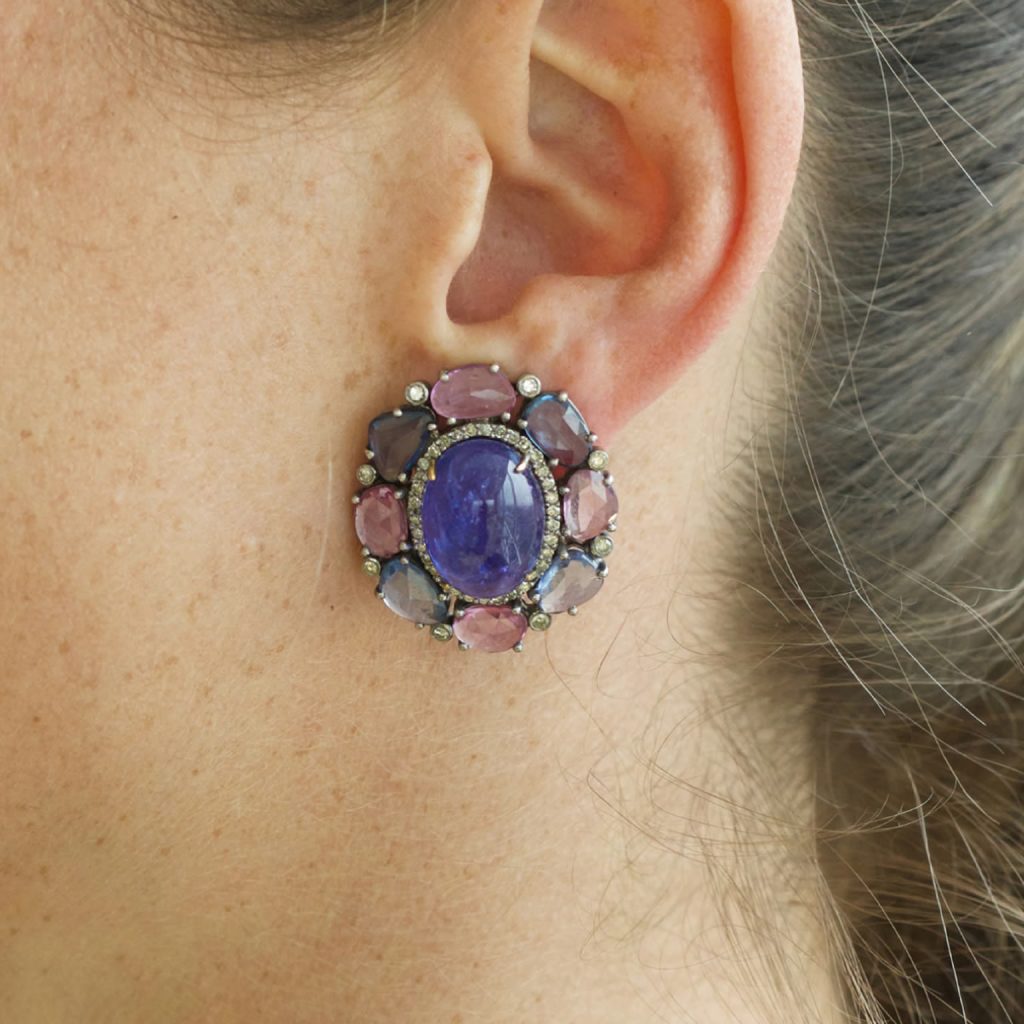
09 Dec Terrific Trio
December has three gemstones: zircon, tanzanite and turquoise
As well as sharing the same calendar month, these three gemstones are all predominantly recognised for their blue tone.
But there’s little else they have in common.
One was mined and valued by ancient civilisations in both the Middle East and the Americas.
Another is almost as old as the planet itself, and has been known by mankind since the earliest civilisations.
And the last is a relative newcomer at only several hundred million years old, and was only discover by men in 1967.
Let’s look at all of these beautiful gemstones in a little more detail.
Ancient turquoise
Turquoise is one of the oldest gemstones known to man, and one of the first gems to be mined. It’s believed to have been discovered in what was then north east Persia (today Iran, Turkistan and Turkmenistan) around 4,000 BC.
The Iranians initially called the mineral pērōzah which means victory. And used it in their architecture to cover the domes of palaces because of its intense blue colour. For the same reason, they thought it was a symbol of heaven on earth.
A stone for the Ancient World
Since, at least, 3,000 BC (at the time of the First Dynasty), the ancient Egyptians have been mining and using turquoise too. It adorns the funeral mask of King Tut who ruled Egypt over 3,000 years ago.
Many other ancient civilisations have been drawn to its beautiful colours. It was also worn and loved by the rulers of Persia, Mesopotamia, the Indus Valley and China.
And a stone for the New World
It’s been mined and used in the New World too, long before Columbus landed. Deposits have been found in California and New Mexico that have been mined by Native Americans, using stone tools. The Aztecs and Native Americans wore it as a decorative stone too.
The Apaches thought turquoise could be found at the end of a rainbow, as well as that attaching it to a bow made their aim more accurate.
The Pope didn’t like turquoise though
However, despite being introduced into Europe via the Silk Road hundreds of years.
previously, turquoise didn’t become popular in the West until the 14th century – probably as a result of the decline of the Roman Catholic Church’s influence which had forbidden the use of turquoise in secular jewellery.
The country named the stone that named the colour
It was when turquoise came into the west via Turkey, that it gained its name, derived from – the French who calling it “pierre turquois” (or Turkish stone). And it’s the only gem stone to have a colour named after it. Turquoise was first used as the name of a colour in English in 1573.
Mix and match
It’s frequently set with other gems or precious metals.
In the Georgian era, turquoise was set together with clusters of rubies and gems in sentimental gold padlocks, hearts and friendship rings. In the Victorian age its popularity soared higher as it became fashionable to mount it in gold. Then in the 20th century, it became known as an Arts and Crafts Jewel, widely used by designer craftsmen like Archibald Knox for Liberty & Co. Wallis Simpson, the woman for whom King Edward VIII gave up his throne, wore a famous amethyst and turquoise necklace made by Cartier.
How turquoise is created
Turquoise forms typically when rain or snow infiltrates the earth’s surface and filters through copper crystals, which then form into veins that later turn into turquoise. It’s a process that normally takes around 30 million years or so, and in arid environments such as Egypt or the southwest United States.
A host stone makes the difference
Turquoise is always formed on another, completely different material, such as limestone or sandstone, called a host rock.
This host rock gives the turquoise values of its own that can either increase or decrease the worth of the stone. It’s also the reason no two turquoise stones are alike, with the host rock leaving an imprint of unique colours and patterns.
Today turquoise is still mined in many parts of the world, including the Middle East, New Mexico, Arizona and Nevada. Although the world’s largest producer is China.
Hard or soft
Turquoise is an opaque stone that’s found in shades of blue and green. It’s about as hard as glass, varying between 5 to 6 on the Mohs scale. It’s harder the closer it is to the earth’s surface, as it’s had longer to dry. Softer turquoise discovered lower down is like chalk, too soft and porous to be used without further treatment.
How much?
Its value varies enormously, from a few pennies to almost one thousand pound per carat, although the stones typically on sale are around £5 to £10 per carat.
The bigger the better
Because, as with many gemstones, bigger rocks are rarer, the price per carat increases with the size of the stone too. The composition of the stone will affect its price too.
The rarer the better
Generally speaking, the more grainy or powdery it is, the less it’s worth. Cut too, is important, but unusually for a gem stone so is the mine in which it was un-earthed.
Large mines such as those found in China produce a lot of turquoise, but smaller ones, for example those found in Nevada, produce just a handful of nuggets. So small, in fact, that they are called “hat mines” – the amount of turquoise that comes out the earth can only fit in a miner’s hat. But because this turquoise is so rare, it’s more valuable than mass produced turquoise gemstones.
Everyone has a favourite colour
The colour is the most controversial indicator of the stone’s value, because the best colour is subjective and goes in and out of fashion. The ancients said blue, moderns tend to prefer green. That’s why clarity trumps colour – so the colour’s purity and clearness is what to look out for.
The celebs choice of jewellery
Of course it’s not just royalty who are fans of citrine. It was very popular in the early 20th century in the Art Deco era. Hollywood stars embraced it, and movie icons like Greta Garbo and Joan Crawford were frequently seen wearing large, elaborately designed citrine-adorned jewellery.
In the 1940’s Cartier were renowned for making some fabulous pieces with dark and light citrines – chic, iconic and still valued today.
Fast forward to the present and you’ll see modern celebrities like Emma Watson, Naomie Harris, Kate Winslet, and Tara Reid wearing beautiful citrine jewellery at red-carpet events. And Angelina Jolie donated a large citrine necklace to the Smithsonian Institution’s National Gem Collection.

Tanzanite – old as the hills but only discovered recently
Colour brings us neatly onto December’s next gemstone: tanzanite.
Its vivid blue makes it popular with many.
It was formed around 585 million years ago, created by massive plate tectonic activity and intense heat. As pressure mounted, very hard granular rocked called quartzites, were pushed into isolated hills or inselbergs. And the pressure, together with the soaring temperatures caused crystals of tanzanite to grow. The longer the process took, the bigger the crystal.
Only available in one place
Unlike most precious stones that can be found all over the world, tanzanite only comes from one small area. It’s found exclusively in a place called Merelani, in Tanzania, in the shadow of Mount Kilimanjaro. And it’s only found here in a very small area, approximately 4.3 miles or 7km long and 1.2 miles or 2 km wide.
A new and different gemstone is discovered
As well as having exceptional geography, only being mined in one tiny part of the world, tanzanite also has a very brief history in comparison to other gemstones. It was only discovered very recently – in July 1967 to be precise.
Tiffany & Company recognised the potential of the stone. When one of the newly discovered gemstones was taken to New York and shown to Henry Platt, Chairman of Tiffany and Company and grandson of the founder, he immediately fell in love with it.
He described it as “the loveliest blue gemstone discovered in over 2,000 years” and successfully bid to become its main distributor.
Tiffany’s named it
Tanzanite is named after the country it is found in, Tanzania, by the company Tiffany, who had exclusive marketing rights to it, for the first few years after its discovery. It was to rapidly become one of the world’s most popular coloured stones next to Blue Sapphire – some rise to ascendency for such a young gemstone.
Tiffany’s original marketing also had the memorable campaign line that tanzanite could only be found in two places “in Tanzania and in Tiffany’s”.
Rare but affordable
All tanzanite found on the market is natural, as the stone has not yet been successfully synthesized. It’s all heat treated too, a process that produces a stronger violet-blue colour.
Because this heat treatment is universal, it won’t affect the price of the stone.
Called a “geological phenomenon”, because it can only be found in one small area of just one country, the gem is 1,000 times more rare than diamonds.
Yet its scarcity is not reflected in its price, and it remains one of the more affordable gemstones.
Three in one
It’s one of the only trichroism gemstones , where trichroism is an optical phenomenon in which a substance has three different colours when observed at different angles – in tanzanite’s case alternatively appearing blue, violet or reddish burgundy depending on crystal orientation.
But blue is best
It’s this property that makes the cutting of the stone so important, and much more complicated than for most other gemstones. A skilled cutter will always try to shape the gemstone in a way to accentuate the blue, as vivid-blue is tanzanite’s most sought-after colour. Tanzanite has such a reputation for the depth and hue of its blue, that even the most stunning sapphires can look pale in comparison.
Size matters
Other factors affecting tanzanite’s value, include its carat weight.
And, like many other gemstones, the price of the stone increasing with how heavy it is.
Large tanzanite gems however are extremely rare, as larger crystals take millions of years longer to grow than less sizeable stones. The size also influences colour, over five carats they tend to be deep blue or violet, and over 100 carats dark black-blue. These latter stones are the rarest tanzanite crystal of all, and consequently most valuable, extremely popular with investors and collectors.
You might also be interested to know, that the largest tanzanite officially listed in the Guinness book of records and the world’s largest rough tanzanite was a 16,839 carat (3.38 kg, or 7.46 lb) stone mined in 2005.
Clearly better
Good clarity is essential if you want a quality coloured gemstone, and tanzanite is no exception.
Inclusions should not be visible to the naked eye, or the stone will decline in value.
The location of the inclusion plays an important part in tanzanite’s clarity grading. If it’s in a relatively inconspicuous place such as the girdle of the stone, it will affect the stone’s quality less than somewhere more prominent.
Celebs who are feeling blue
Tanzanite’s deep blue hue makes this relatively recent addition to the gemstone family popular amongst celebrities.
Shaun Robinson, Kate Middleton and Penelope Cruz are regularly seen wearing tanzanite for special appearances.
When Beyonce was seen wearing a blue tanzanite, the rumour was that it was a gift from the husband Jay Z to celebrate the birth of her daughter. Sarah Jessica Parker, sported a round tanzanite and diamond pendant paired with a tanzanite ring at the 2013 Tiffany and Co Blue Book collection.
Anne Hathaway wore tanzanite and diamond earrings at an Oscar award ceremony, and Cate Blanchett was seen wearing a tanzanite and diamond necklace in the 2011 Oscars too.
Blue sapphires are not us
Tanzanite looks very similar to blue sapphires in appearance. Indeed, it’s hard to tell them apart, unless you are an expert. However, when you explore deeper the two stones are very different to one another.
The hard facts
And perhaps the main point of difference is their relative hardness.
Sapphires rank 9 on the Mohs scale, which shows a stone’s propensity to scratch.
It’s the third most durable gemstone used in jewellery after diamonds and moissanite. Which is why sapphires are excellent for everyday wear, and so often used in engagement rings.
Tanzanite, in contrast, is much softer, and ranks only 6 to 6.5 on the Mohs scale. That means it’s easily damaged, and can break if hit. So it needs to be put into a secure setting if worn regularly, and carefully looked after.
A beautiful gemstone? Or an investment opportunity?
Price is the other main point of difference.
If all other things are equal, such as carat weight, colour, clarity and cut, sapphire is considerably more expensive than tanzanite.
Which is good news if you want the sapphire look without the high price tag.
Also, although it is impossible to predict how the cost of gemstones will change over time with certainty, consider this.
Hurry while stocks last
At the current rate of mining it’s estimated that the world’s known available supply of tanzanite will be exhausted within 25 or so years. And when tanzanite has been mined out, who knows how high its price will rise?
So whether you’re buying for yourself, or a friend, tanzanite might not just be a beautiful gemstone, but also an investment opportunity.

Z is for zircon, the third of December’s gemstones
Zircon is the last of the three birthstones for December.
And also the oldest in terms of geology. Many gemstones first began forming hundreds of millions of years ago, but zircon is in a class of its own.
Much, much older than life on earth
Recently in 2014 a piece of zircon that was found in Australia dating back nearly 4.5 billion years, making it only (and we say only!) 1.5 billion years less than the planet itself. It’s formed over time by the weathering of carbonated and other types of rock due to the movement of heated water beneath the surface of the earth. The most likely reason being volcanic magma heating surrounding water.
Zircon features in ancient history too
Zircon has also featured in human history, since the beginning of civilisation. It’s mentioned in the bible under the name of hyacinth or jacinth and a variety of zircon was one of the 12 stones of Israel mentioned in the bible.
Not a diamond, but not man-made either
However, zircon’s image has suffered in recent years, firstly because in its clear form it as used as a cheap substitute for diamonds, and also because of confusion with a man-made diamond substitute, cubic zirconium.
Look what you’ve dredged up!
Zircons are a common constitute of most sands and more easily found in sedimentary deposits, so over 2000 years it was mined from stream gravels that extracted the beautiful gemstone. But now the gem is sourced by dredging.
Not rare, but still a stunner
Because of its ubiquity, zircon tends to be less precious than most other gem stones.
But that doesn’t make it any less beautiful.
It’s a stunning gem that comes in an array of colours from golden yellow to deep red, green, blue and black. The rarest and one of the most valuable is green, although vivid blue is very popular and commands a similarly higher price.
The 4 Cs are still relevant
Zircon’s price is still determined by the four Cs, colour, clarity, cut and carat and can cost anywhere around $50 to $400 per carat, depending on the quality factors of the stone.
But if you’re thinking of buying a piece bear in mind that large zircon stones are particularly valuable too. That’s because they nearly always naturally occur as small grains in sedimentary and metamorphic rocks.
And as with all precious stones, if you’re sensible you’ll want an expert to evaluate it to make sure that it’s worth the asking price.
Turn to a traditional jeweller
Whatever type of precious stone or gem you’re interested in, it’s always safer to seek the advice of a traditional jeweller like John Lloyd Morgan for guidance.


